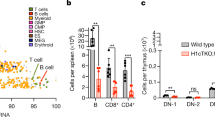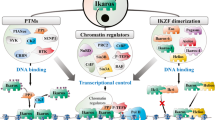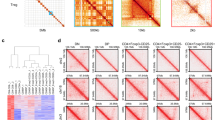Abstract
The forkhead box transcription factor FoxP3 controls the development and function of CD4+CD25+ regulatory T (Treg) cell. FoxP3 modulates gene expression in Treg cells by multiple epigenetic mechanisms that are not clearly defined. We identified FoxP3-interacting proteins in human T cells by co-immunoprecipitation/MS. We discovered that FoxP3 interacted with linker histone H1.5 via the leucine zipper (LZ) domain. Two independent IPEX patient-derived single residue mutations in the LZ of FoxP3 both abrogated its interaction with H1.5. Functionally, FoxP3 and H1.5 cooperatively repressed interleukin-2 (IL-2) expression in human T cells; and silencing of H1.5 expression inhibited the ability of FoxP3 to suppress IL-2 expression. We show that FoxP3 specifically enhanced H1.5 association at the IL-2 promoter, but reduce its association at the CTLA4 promoter, correlated with higher or lower histone acetylation of the respective promoters. Finally, silencing of H1.5 expression in human Treg cells impaired the Treg function to suppress target T cells. We conclude that FoxP3 interacts with H1.5 to alter its binding to target genes to modulate their expression and to program Treg function.
This is a preview of subscription content, access via your institution
Access options
Subscribe to this journal
Receive 6 digital issues and online access to articles
$119.00 per year
only $19.83 per issue
Buy this article
- Purchase on Springer Link
- Instant access to full article PDF
Prices may be subject to local taxes which are calculated during checkout






Similar content being viewed by others
References
Brunkow ME, Jeffery EW, Hjerrild KA, Paeper B, Clark LB, Yasayko SA et al. Disruption of a new forkhead/winged-helix protein, scurfin, results in the fatal lymphoproliferative disorder of the scurfy mouse. Nat Genet 2001; 27: 68–73.
Schubert LA, Jeffery E, Zhang Y, Ramsdell F, Ziegler SF . Scurfin (FOXP3) acts as a repressor of transcription and regulates T cell activation. J Biol Chem 2001; 276: 37672–37679.
Bennett CL, Christie J, Ramsdell F, Brunkow ME, Ferguson PJ, Whitesell L et al. The immune dysregulation, polyendocrinopathy, enteropathy, X-linked syndrome (IPEX) is caused by mutations of FOXP3. Nat Genet 2001; 27: 20–21.
Wildin RS, Ramsdell F, Peake J, Faravelli F, Casanova JL, Buist N et al. X-linked neonatal diabetes mellitus, enteropathy and endocrinopathy syndrome is the human equivalent of mouse scurfy. Nat Genet 2001; 27: 18–20.
Fontenot JD, Gavin MA, Rudensky AY . Foxp3 programs the development and function of CD4+CD25+ regulatory T cells. Nat Immunol 2003; 4: 330–336.
Hori S, Nomura T, Sakaguchi S . Control of regulatory T cell development by the transcription factor Foxp3. Science 2003; 299: 1057–1061.
Yagi H, Nomura T, Nakamura K, Yamazaki S, Kitawaki T, Hori S et al. Crucial role of FOXP3 in the development and function of human CD25+CD4+ regulatory T cells. Int Immunol 2004; 16: 1643–1656.
Wang B, Lin D, Li C, Tucker P . Multiple domains define the expression and regulatory properties of Foxp1 forkhead transcriptional repressors. J Biol Chem 2003; 278: 24259–24268.
Li B, Samanta A, Song X, Iacono KT, Bembas K, Tao R et al. FOXP3 interactions with histone acetyltransferase and class II histone deacetylases are required for repression. Proc Natl Acad Sci USA 2007; 104: 4571–4576.
Ziegler SF . FOXP3: of mice and men. Annu Rev Immunol 2006; 24: 209–226.
Campbell DJ, Ziegler SF . FOXP3 modifies the phenotypic and functional properties of regulatory T cells. Nat Rev Immunol 2007; 7: 305–310.
Chae WJ, Henegariu O, Lee SK, Bothwell AL . The mutant leucine-zipper domain impairs both dimerization and suppressive function of Foxp3 in T cells. Proc Natl Acad Sci USA 2006; 103: 9631–9636.
Wu Y, Borde M, Heissmeyer V, Feuerer M, Lapan AD, Stroud JC et al. FOXP3 controls regulatory T cell function through cooperation with NFAT. Cell 2006; 126: 375–387.
Fontenot JD, Rasmussen JP, Gavin MA, Rudensky AY . A function for interleukin 2 in Foxp3-expressing regulatory T cells. Nat Immunol 2005; 6: 1142–1151.
Setoguchi R, Hori S, Takahashi T, Sakaguchi S . Homeostatic maintenance of natural Foxp3(+) CD25(+) CD4(+) regulatory T cells by interleukin (IL)-2 and induction of autoimmune disease by IL-2 neutralization. J Exp Med 2005; 201: 723–735.
Ono M, Yaguchi H, Ohkura N, Kitabayashi I, Nagamura Y, Nomura T et al. Foxp3 controls regulatory T-cell function by interacting with AML1/Runx1. Nature 2007; 446: 685–689.
Doenecke D, Albig W, Bode C, Drabent B, Franke K, Gavenis K et al. Histones: genetic diversity and tissue-specific gene expression. Histochem Cell Biol 1997; 107: 1–10.
Fan Y, Nikitina T, Zhao J, Fleury TJ, Bhattacharyya R, Bouhassira EE et al. Histone H1 depletion in mammals alters global chromatin structure but causes specific changes in gene regulation. Cell 2005; 123: 1199–1212.
Fan Y, Sirotkin A, Russell RG, Ayala J, Skoultchi AI . Individual somatic H1 subtypes are dispensable for mouse development even in mice lacking the H1(0) replacement subtype. Mol Cell Biol 2001; 21: 7933–7943.
Fan Y, Nikitina T, Morin-Kensicki EM, Zhao J, Magnuson TR, Woodcock CL et al. H1 linker histones are essential for mouse development and affect nucleosome spacing in vivo. Mol Cell Biol 2003; 23: 4559–4572.
Lee H, Habas R, Abate-Shen C . MSX1 cooperates with histone H1b for inhibition of transcription and myogenesis. Science 2004; 304: 1675–1678.
Jiang Q, Su H, Knudsen G, Helms W, Su L . Delayed functional maturation of natural regulatory T cells in the medulla of postnatal thymus: role of TSLP. BMC Immunol 2006; 7: 6.
Antons AK, Wang R, Oswald-Richter K, Tseng M, Arendt CW, Kalams SA et al. Naive precursors of human regulatory T cells require FoxP3 for suppression and are susceptible to HIV infection. J Immunol 2008; 180: 764–773.
Marson A, Kretschmer K, Frampton GM, Jacobsen ES, Polansky JK, MacIsaac KD et al. Foxp3 occupancy and regulation of key target genes during T-cell stimulation. Nature 2007; 445: 931–935.
Lennox RW, Cohen LH . The histone H1 complements of dividing and nondividing cells of the mouse. J Biol Chem 1983; 258: 262–268.
Li B, Samanta A, Song X, Furuuchi K, Iacono KT, Kennedy S et al. FOXP3 ensembles in T-cell regulation. Immunol Rev 2006; 212: 99–113.
Trojer P, Li G, Sims III RJ, Vaquero A, Kalakonda N, Boccuni P et al. L3MBTL1, a histone-methylation-dependent chromatin lock. Cell 2007; 129: 915–928.
Krishnakumar R, Gamble MJ, Frizzell KM, Berrocal JG, Kininis M, Kraus WL et al. Reciprocal binding of PARP-1 and histone H1 at promoters specifies transcriptional outcomes. Science 2008; 319: 819–821.
Coffield VM, Jiang Q, Su L . A genetic approach to inactivating chemokine receptors using a modified viral protein. Nat Biotechnol 2003; 21: 1321–1327.
Vitriol EA, Uetrecht AC, Shen F, Jacobson K, Bear JE . Enhanced EGFP-chromophore-assisted laser inactivation using deficient cells rescued with functional EGFP-fusion proteins. Proc Natl Acad Sci USA 2007; 104: 6702–6707.
Holmes D, Knudsen G, Mackey-Cushman S, Su L . FoxP3 enhances HIV-1 gene expression by modulating NFkappaB occupancy at the long terminal repeat in human T cells. J Biol Chem 2007; 282: 15973–15980.
Acknowledgements
We thank Drs Yi Zhang, Art Skoultchi, Jenny Ting, Yue Xiong and members of the Su lab for critical reading and/or discussion of the manuscript. The project was supported by grants from NIH (AI048407 & AI077454 to LS, AI065303 to DU) and UNC training grant (106693-39-RFMT to SMC).
Author information
Authors and Affiliations
Corresponding author
Ethics declarations
Competing interests
The authors declare no conflict of interest.
Additional information
Supplementary Information accompanies the paper on Genes and Immunity website
Supplementary information
Rights and permissions
About this article
Cite this article
Mackey-Cushman, S., Gao, J., Holmes, D. et al. FoxP3 interacts with linker histone H1.5 to modulate gene expression and program Treg cell activity. Genes Immun 12, 559–567 (2011). https://doi.org/10.1038/gene.2011.31
Received:
Revised:
Accepted:
Published:
Issue Date:
DOI: https://doi.org/10.1038/gene.2011.31
Keywords
This article is cited by
-
NCAPG promotes the oncogenesis and progression of non-small cell lung cancer cells through upregulating LGALS1 expression
Molecular Cancer (2022)
-
Regulatory T cells and immune regulation of allergic diseases: roles of IL-10 and TGF-β
Genes & Immunity (2014)
-
Genetic polymorphism in FOXP3 gene: imbalance in regulatory T-cell role and development of human diseases
Journal of Genetics (2013)



